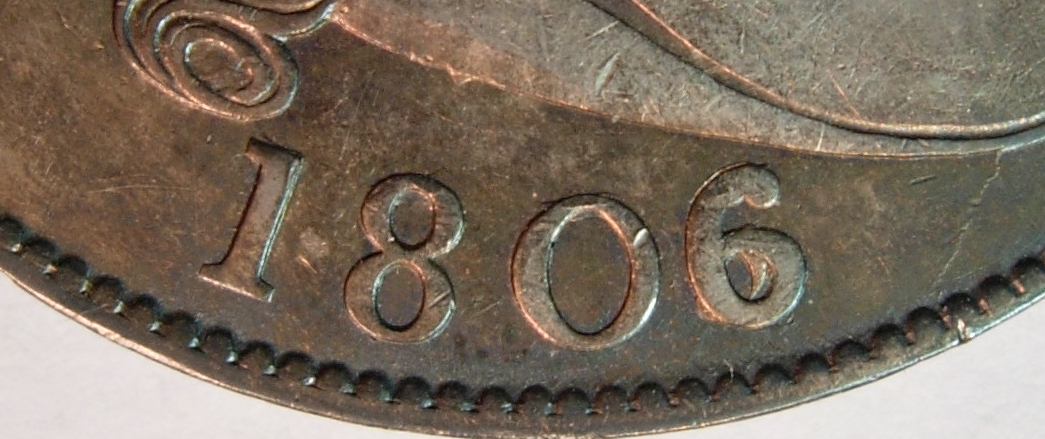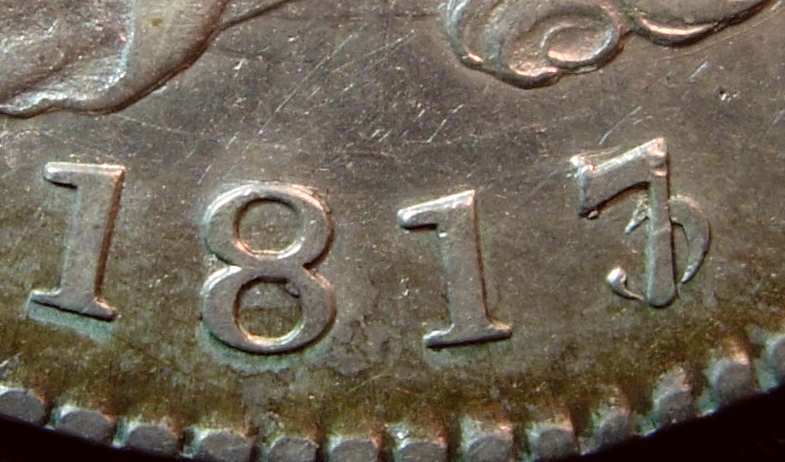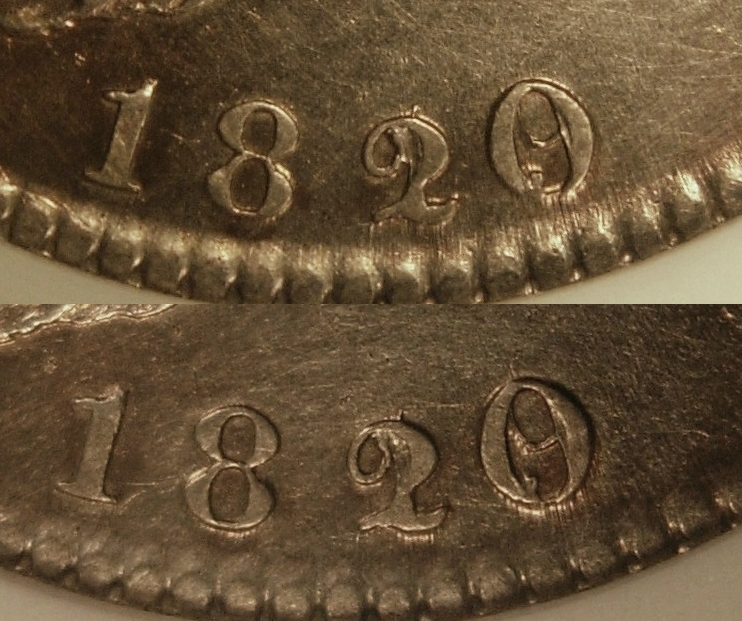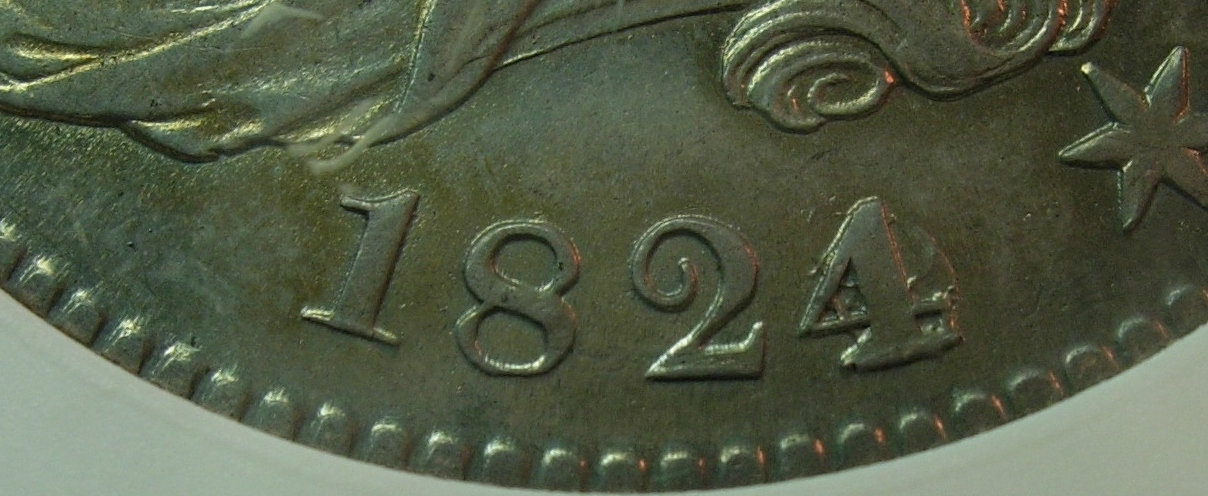Question concerning overdates and overmintmarks
 errormaven
Posts: 1,170 ✭✭✭
errormaven
Posts: 1,170 ✭✭✭
Most overdates consist of a normal date that overlies an earlier date that is thin, often incomplete, and shows low relief. Most overmintmarks show a strong mintmark overlying a different mintmark that is thin, often incomplete, and shows low relief.
The traditional explanation is that the area around the original date/mintmark was ground away, leaving only the deepest portions of these die recesses intact. This action should leave a recess in the die face and a corresponding elevation on the coin. But no such elevation is ever found.
It doesn't appear that the near-loss of the original elements is due to more widespread abrasion that would create a more gentle slope in the die face. Nearby and distant design elements typically show no evidence of intentional die abrasion.
It's equally clear that the affected design elements are not being ground off a working hub, as that would leave the design elements with a normal width in conjunction with low relief.
Is it possible that the underlying design was never punched-in deeply in the first place?
Die variety experts, please chime in.
-- Mike Diamond
The traditional explanation is that the area around the original date/mintmark was ground away, leaving only the deepest portions of these die recesses intact. This action should leave a recess in the die face and a corresponding elevation on the coin. But no such elevation is ever found.
It doesn't appear that the near-loss of the original elements is due to more widespread abrasion that would create a more gentle slope in the die face. Nearby and distant design elements typically show no evidence of intentional die abrasion.
It's equally clear that the affected design elements are not being ground off a working hub, as that would leave the design elements with a normal width in conjunction with low relief.
Is it possible that the underlying design was never punched-in deeply in the first place?
Die variety experts, please chime in.
-- Mike Diamond
Mike Diamond is an error coin writer and researcher. Views expressed here do not necessarily reflect those held by any organization I am a member of.
0
Comments
Regarding the underdates/mintmarks that are thinner/weaker/incomplete than the re-entered date: my understanding for this phenomenon is that the walls of a punch are not perpendicular to the surface of the die but instead are angled so that the sides of the punch get closer to each other. This makes a triangular hole in the die rather than rectangular. The reason for doing that would be so the dies release more easily after striking.
If you grind away the top of a angled punched hole, you gradually expose a thinner hole.
That's theory only. I've never seen a punch tool.
Bernie has an additional related theory about dies being put in production for a period before being rehubbed which so far we have been unable to prove or disprove.
http://www.shieldnickels.net
As I understand it, basining also involves abrading or polishing the die face. If my understanding is accurate, then there should be evidence of design attenuation elsewhere on the coin, and there isn't.
I would welcome an e-mail from Bernie T or anybody else who has some insight.
I did contact Ken Potter and he's just as puzzled as I am on this issue.
http://www.shieldnickels.net
http://www.shieldnickels.net
Keeper of the VAM Catalog • Professional Coin Imaging • Prime Number Set • World Coins in Early America • British Trade Dollars • Variety Attribution
As far as work-hardened dies, they could be re-annealed.
http://www.shieldnickels.net
That said, I doubt that a weak initial PUNCHING (as opposed to the incomplete initial hubbing on the 1942/41 dimes) was the cause of the weak older date or mintmark. Look at the various 1849/1846 half dimes (note: some people believe they are 1849/1848) and 1900-O/CC dollars. In both cases there are records of older unused dies being returned to the Philadelphia die shop and recycled. It is impossible that so many dies would have originally been sent out with weak, inadequate dates or mintmarks. Something was done to minimize the original date or mint mark. We just don't know what yet.
I could see the possibility that it may have happened once to one particular die where the engraver gave a die a tap with an "x" punch and said "Oops! I'm supposed to be making "y," but I cannot think of an example.
TD
I'm going to give it some thought later also; however, I think there is one obvious conclusion we all CAN agree on at the moment:
IMO, the way these varieties were made depends on the time period we are talking about. For example, I believe the die for an 1807/6 Large cent was made differently than an 1880/79 Morgan dollar.
My discussion of this long-dormant subject appears in this week's Coin World (February 25, 2019).
I shall go look that up.
TD
Interesting column. My intuitive feeling is that Scenario 4 is not likely, but I can neither prove nor disprove this.
Since the column make me think about the problem, how about this wild speculation:
We have each seen evidence of the cratering effect that mechanically punching a letter into a die can throw up around the letter. Normally this is polished away before the die is hardened and used. The creation of such a crater ring would imply that the flat base of the letter punch did not reach the level of the field of the die, or else it would have flattened down that crater ring.
What is some dies were overmintmarked with the die still soft and the crater not yet polished away? As the letter punch entered the die, with more force than usual because the Engraver knows he is trying to obliterate the first letter, the flat base of the punch could reach the field of the die and push the metal in the crater ring back down into the die. Since the metal has to go somewhere, along with the metal displaced by the overpunching, the metal could partially fill in the void created by the initial punching, leaving the original letter thin and attenuated.
Dies being overmintmarked that did not have a crater ring, either because it was not formed during the initial punching or because it had already been polished away, would show a more complete undermintmark.
I admit that this is a new theory just created in an undercaffeinated mind. I shall cogitate upon it further.
TD
The defective numeral or letter was not "ground off the die." All that does is make a larger depression which is nearly impossible to fill and smooth. A coin from such a die would have a raised lump where the grinding was done. ("Dig a hole and make a pole.")
Repair and redating changed with available technology and improved information about die steel and various treatments from industrial experiences. This is discussed in From Mine to Mint, which members might wish to consult before asking further questions. (You can also ask your dentist how cavities were repaired in the old days - 1960s.)
I can add some close-ups of of a few overdates in early halfs if it will help.



